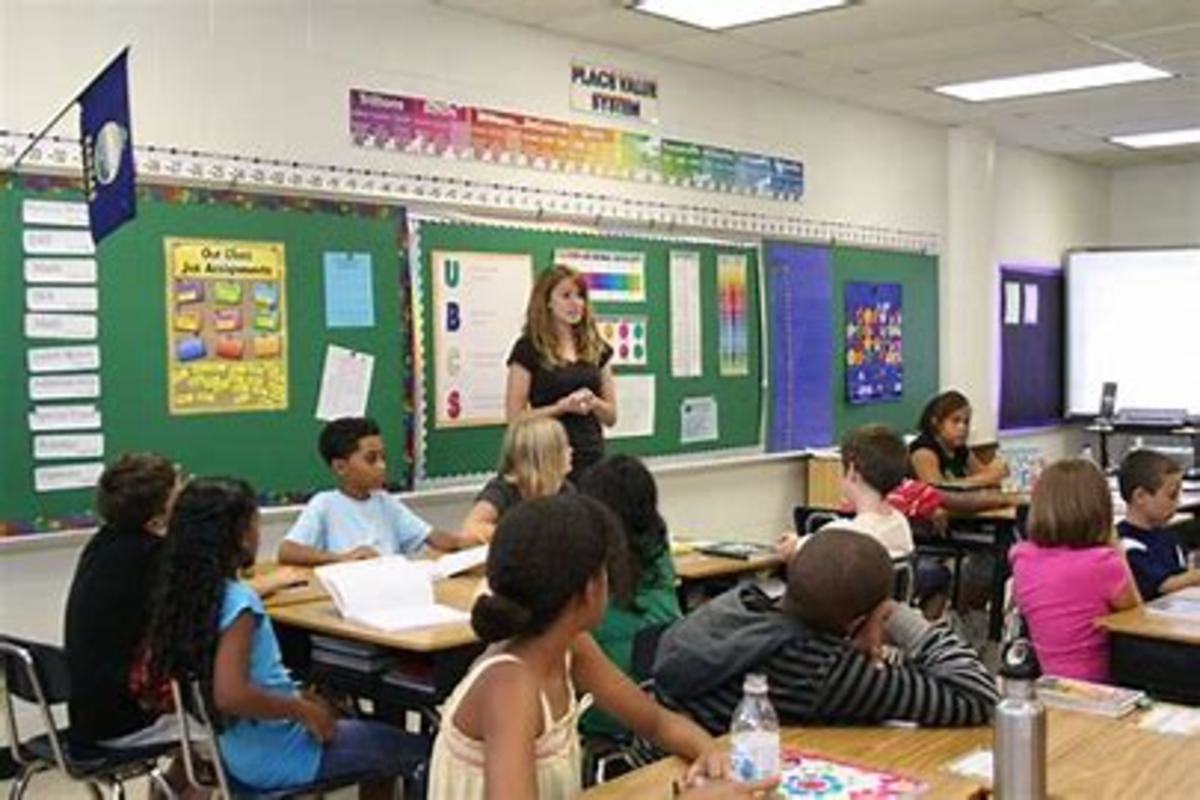Have Middle Schools Lost Sight of The Middle?

When Economics Impacts Education
Back in 1982-’83 or thereabouts, the middle school concept was embraced by our local school district (and many others) as the panacea to replace what many saw as an outdated junior high school system. Ninth grade was bumped up to the high school; those 14-year-olds who, under the old system, had been “kings and queens of the hill” (complete with the superior attitude that often accompanied that honor) suddenly found themselves in the postion of lowly high school freshmen. Accordingly, sixth grade was moved into the bottom rung on the middle school ladder.
My daughter was a member of the first class to be welcomed into sixth grade at the middle school, while I continued to do substitute teaching at her school almost daily (as I had done for the past five years, when it had been a junior high school). Despite the fact that, as a high-school-trained English teacher, I preferred to sub in classes no lower than grade 8, I found the changes to be positive. For one thing, the middle school team concept, whereby a group of four or five academic teachers shared the same students, was a godsend compared to the every-teacher (and student)-for-herself approach of junior high school. A team of teachers who met on a regular basis (every other day) could keep a much closer pulse on student progress, problems, and needs. Another plus inherent in the middle school philosophy was the addition of a curriculum specialist, a position that, ideally, would add an administrator called a Curriculum Coordinator who would not be responsible for handling student discipline and thereby would be free to deal with curriculum issues. Also, at my daughter’s middle school, at least, the sixth graders were introduced gradually into the middle school experience; all academic classes (language arts, reading, math, social studies and science) were taught in a designated “sixth grade wing,” which sixth graders left only for lunch and related arts classes. (The addition of Reading as an academic subject in sixth and seventh grades is another example of changes that came with the middle school philosophy.)
It seemed that many teachers at the local high schools, however, were not pleased with the changes from their end. Those teachers were not used to dealing with the “immaturity” of ninth graders ( Some would substitute the word “immaturity” with “hormones.”) From the students’ point of view, it couldn’t have been easy for them, either, to have missed out on the coveted elitist postion ninth graders had enjoyed for years during the Era of the Junior High only to find themselves at the bottom of the pecking order (with both students and teachers) at the high school. It took quite awhile for freshmen to be welcomed and assimilated into the high schools. That is a saga in itself.
Middle School Staffing... Personally Speaking
Staffing at the new middle schools faced another unique challenge: whereas most junior high school teachers had certification in Secondary Education with a BA in a particular subject area, sixth grade had always been taught at the elementary schools by- who else- teachers who had comprehensive degrees in Elementary Education. The middle school concept gave elementary-certified teachers who preferred teaching “older” kids the opportunity to move to middle school. Also, most middle school administrators came from elementary schools; some of them effected major changes in philosophy and policy which did not sit well with some of the secondary-oriented staff.
Eventually, I was hired as a full-time language arts teacher at the middle school level. (“Language Arts,” I have always felt, is a misnomer; why is the subject referred to as “language arts” in the middle schools and “English” at the high schools when almost all of the people who teach those courses- with the exception of sixth grade teachers who have elementary certification- are certified in English?To my knowledge, there is no such animal as a “Language Arts” certification.) By that time, the team concept was firmly in place, and the transition from junior high to middle school had gone relatively smoothly. My first assignment as a full-time (language arts) teacher was in seventh grade, which definitey was not high on my “preferred grades” list. I was so happy finally to have a full-time position, however, that I even agreed to direct the sixth grade chorus. (That in itself woulld make quite a story!) My experiences that year were such that I was thrilled to be placed in eighth grade the following year with many of the students I’d taught in seventh grade. In fact, I’d taught all of the students- save one transfer from parochial school- in one of my classes. This saved a lot time usually given to explaining expectations, guidelines etc., and I was able to tackle the subject matter almost immediately. I also traded in the sixth chorus position for that of advisor to the school newspaper, which was supplemented with advisor to the school literary magazine and, later, advisor to the school yearbook.

Reading versus Literature
One of the major issues that I tried to clarify for my eighth graders was the fact that “reading” no longer existed as an academic class (although some students still qualified for “extra” Title I Reading help), and that all the literature we would do that year was indeed that: literature, a term which I feel elevates the genre to the position it deserves. I also feel that making this distinction helps build student respect for a craft rather than perceiving it as a drudgery that ends with the dreaded, obligatory ”book report.” In fact, when I was expected to have kids do “book reports” I always tried to make the assignment unique: one time they might try to “sell” a book to a class, another time they would present the report in the voice of the main character, and still another time they would do a book review. Writing of all genre (creative, persuasive, research, journalistic, personal, poetic, etc.) also was a major focus of my class, and I designed many writing assignments around the literature we were reading at the time. In conjunction with this, I also placed considerable emphasis on correct grammar and usage, particularly since otherwise top notch writing and public speaking can be rendered ineffective by poor grammar. I attempted to strengthen public speaking skills, also, with activties such as mock trials and debates that reflected the literature we were studying.
The Team Concept At Work
Once I’d experienced the team concept, too, I was convinced that it was the best way to go with middle school students. (The ideal team concept works best with this schedule in place: each member of the academic team teaches five class periods a day. Another period is given to “prep time” and another to team meetings alternating with as assigned time: cafeteria duty, hall duty, class coverage, etc.). Since my team met every other day, we were able to have group consults, do guidance referrals, and meet with parents and/or students as needed. This enabled us to deal with problems in a timely fashion and was particularly helpful in arranging time wth parents and guidance counselors. During team meetings, each member of the team had the opportunity to keep the others apprised of what was being done in his/her class. We were able to plan many units that encompassed more than one subject area. For example, the science teacher required that students in one or two classes of her classes do a major project, complete with research paper. My job was to teach research skills and research paper format, including footnotes and bibliography. The science teacher would correct the papers for content, and I would correct them for form and grammar. When some of the students competed in a statewide competition, both of us would listen to and critique the speeches that were required to present their projects.
The Time Machine Travels in Reverse
Fast forward to the present: September, 2011. Our school district has been forced by a “challenging economy” to play Simon Says, only backwards. The “curriculum coordinator” position was the first casualty; it was eliminated over a year ago. In addition to laying off scores of teachers (most districts seem to prefer the term “furloughs” to “layoffs”), the original Middle School Concept, i.e., the one that had been working, has been reconfigured to meet the needs of the budget rather than those of the students. For one thing, the academic teams have been scrapped in order to enable teachers to pick up an extra academic class and/or an “as assigned” duty. (For example, word has it that quite a few teachers at one middle school serve an entire hour of cafeteria duty every day. If you’ve ever walked through a middle school cafeteria at High Noon, you might recall that your feet wouldn’t move fast enough to get you out of there mucho pronto.) Also, in some cases at least, a teacher’s “class load,” or number of students she teaches, has increased from somewhere around 100 to 180+. (Some might say that this is merely part of The Job. Consider, however, from the persepective of a parent: With almost double the amount of students, the amount of time/attention a teacher can give each student decresases exponentially. Also, time needed to grade papers and return them in a timely manner is impacted to the extent that a language arts teacher, for one, will find herself in perpetual correcting mode. Realistically, I would expect that the number of tests and writing assigments might dwindle as a teacher begins to feel totally overwhelmed.
Another change at the middle school is the addiition of Reading to the eighth grade academic curriculum. This means that the language arts teachers, with certifications in Secondary Education and English, have lost the “literature” component of their courses. Literature now falls in the domain of the Reading teachers, some of whom, at least, have been teaching sixth or seventh grade Reading for years and have lttle or no familiarity with the eighth grade literature curriculum. When a friend and former colleague who has been teaching eighth grade language arts for most of her career told me that she no longer is allowed teach any literature, including all the shorts stories, poetry, novels and novellas ( e.g.: “Flowers For Algernon,” my all-time favorite) we had done for years, I gasped in disbelief. No literature for an English teacher? That has to be the ultimate oxymoron. When I had managed to catch my breath, I managed to choke out, “So what are you allowed to teach?” Her answer was simple. “Grammar and writing.” I’m still shaking my head in disbelief. What’s wrong with a district that insists on labelling a course Language Arts and then proceeds ro remove the study of the fundamental art form from that course?
The final nail in the coffin of the watered-down middle school: the eight class periods a day have been cut even shorter by the addition of a 20-minute homeroom period at both the beginning and the end of each day. I’d like someone on the school board to explain the necessity for not one block of time devoted to something other than the learning process, but two, no less. This sends yet another message to our students about education and priorities.

What Now?
So.... how far have we come since the initial plans to provide adolescents with a smooth transition from the simplicities of elementary school to the intricacies of high school (although I’ve been there, too, and have had a hard time locating “intricacies”)? Let’s see. We’ve gotten rid of the curriculum coordinator, so we’re back to the “every kid for himself” philosophy of yore. Ditto with the team approach, which afforded much-needed support to a hormonally-challenged demographc. We’re abbreviated class time for unknown (economic, perhaps?) reasons as we’ve increased class sizes. (That one’s a no-brainer.) Finally, let us not forget the addition of Reading (which conjures up- for me, at least- elementary school images of Robins and Bluebirds, Daffodils and Daisies, Dick and Jane) to the eighth grade curriculum. Must dollar signs always trump students’ best interests?








